Monday, October 19th, 2020. 12:38 p.m. — When I first arrived at my sit spot, the first thing I noticed was all the noise. Insects and crickets and birds. This is something I’ve noticed each time I’ve walked down to the creek in Beale Garden to sit in nature. During my fifteen minutes of observation, the racket made by all the different organisms living in Beale Garden shrouded everything else. I expected the presence of birds and insects to subside as we move closer to winter, but we are two months from the winter solstice and there seem to be just as many insects and birds, if not more, than in early September.
Though there was an inconsistent chill breeze, this day at my sit-spot was warm and sunny. The abnormally warm temperatures may be why the insects are still prominent in Beale Garden, and this may be why the birds are still there, because they eat the insects. Despite these warm 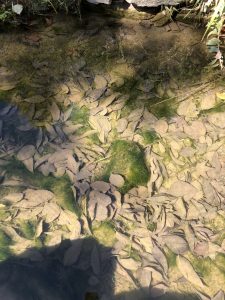 temperatures, I also noticed that all of the trees around Beale creek have golden leaves that they are dropping to the ground. Even the creekbed is coated in the fallen leaves from these surrounding trees.
temperatures, I also noticed that all of the trees around Beale creek have golden leaves that they are dropping to the ground. Even the creekbed is coated in the fallen leaves from these surrounding trees.
As I sat at my sit-spot, I tried to pinpoint the insect and bird species I was hearing (unfortunately, I have not been able to find an app like “iNaturalist” that will classify the animals in an area based on the noise they make. The most prominent noise was the hum of crickets, but I could pinpoint at least five or six other insect noises. And there were around five different bird calls. I saw a few small birds flitting about, but they flew too fast for me to see their coloring or any specific physical attributes, and definitely too quickly for me to get a good picture. As I said earlier, I think there is such a high number of birds in Beale Garden because they eat the large insect population and there are several things that have brought about the large insect population: presence of water (Beale Creek), tall shrubs surrounding the creek, and the warm temperatures.
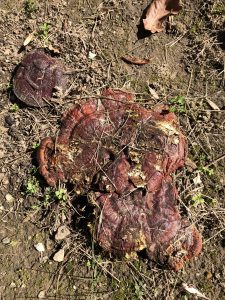 The first species I tried to identify was a mushroom called the “Golden reishi” (Ganoderma curtisii) which I figured out using iNaturalist as well as some of my own online research. Most pictures of Golden reishi I’ve found online are much more beautiful, but this one seems to be beginning to die and decay. Reishi’s are medicinal mushrooms and can be used for sugar regulation for diabetes. This one probably couldn’t be used for any medicinal practices but will hopefully provide food for microorganisms and nutrients for the soil.
The first species I tried to identify was a mushroom called the “Golden reishi” (Ganoderma curtisii) which I figured out using iNaturalist as well as some of my own online research. Most pictures of Golden reishi I’ve found online are much more beautiful, but this one seems to be beginning to die and decay. Reishi’s are medicinal mushrooms and can be used for sugar regulation for diabetes. This one probably couldn’t be used for any medicinal practices but will hopefully provide food for microorganisms and nutrients for the soil.
I also identified a plant growing along the creekbed. It is the Common yucca (Yucca filamentosa). In 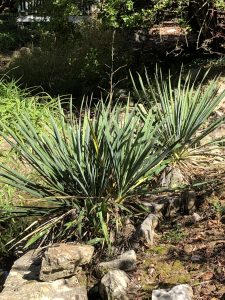 springtime, this is a flowering plant and is native to this area. It looks like a tall spiky grass, but is technically a shrub and is actually evergreen, so as the rest of the plants in Beal Garden grow bare in the wintertime, this shrub will remain looking healthy and green.
springtime, this is a flowering plant and is native to this area. It looks like a tall spiky grass, but is technically a shrub and is actually evergreen, so as the rest of the plants in Beal Garden grow bare in the wintertime, this shrub will remain looking healthy and green.
The last organism I identified were the Water striders (Aquarius remigis) skirting along the top of Beale Creek. I had to identify them purely using online research, as all of my pictures of them were too fuzzy for iNaturalist to see. They are one of the few organisms with the ability to “walk on water,” though it looks more like gliding. They use the surface tension of the water and their long, spindly legs to keep them propelled on top of the water. It looks effortless, but involves a lot of physics.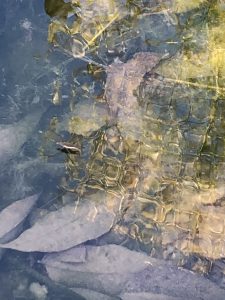
During this sit-spot, I was most struck by how alive this area still is. The movement of Fall into Winter is usually pegged as being one of death. All the trees lose their leaves, animals migrate or move into hibernation. But there is still such a prominent presence of animals in Beale Garden and though the trees are beginning to loose their leaves, the decay that will happen as the leaf matter builds up promises nutrients for new life in the Spring.

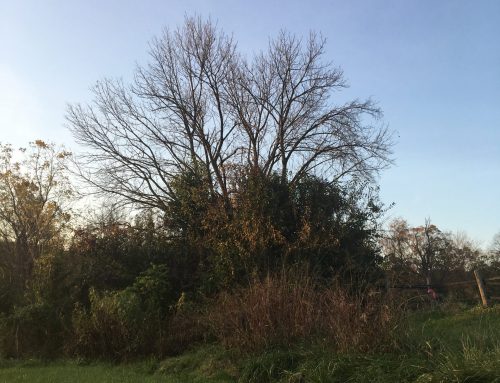
That is so cool that you caught a picture of water striders (Aquarius remigis) hanging out on top of Beale Creek. The only time I get to see water striders are in animal crossing. lol
I love learning about natural medicine. I will have to look into the “Golden Reishi” a bit more. While I don’t it grows in my neck of the woods, it never hurts to learn. I’ve been testing Mulberry Root Bark for lowering blood sugar levels as well. My grandmother has been a willing participant. She like many people that struggle with illness is constantly looking for more natural and accessible remedies. Do you haven any interest in pharmacognosy?
Lovely blog Isabel – really enjoyed your connection to your spot!